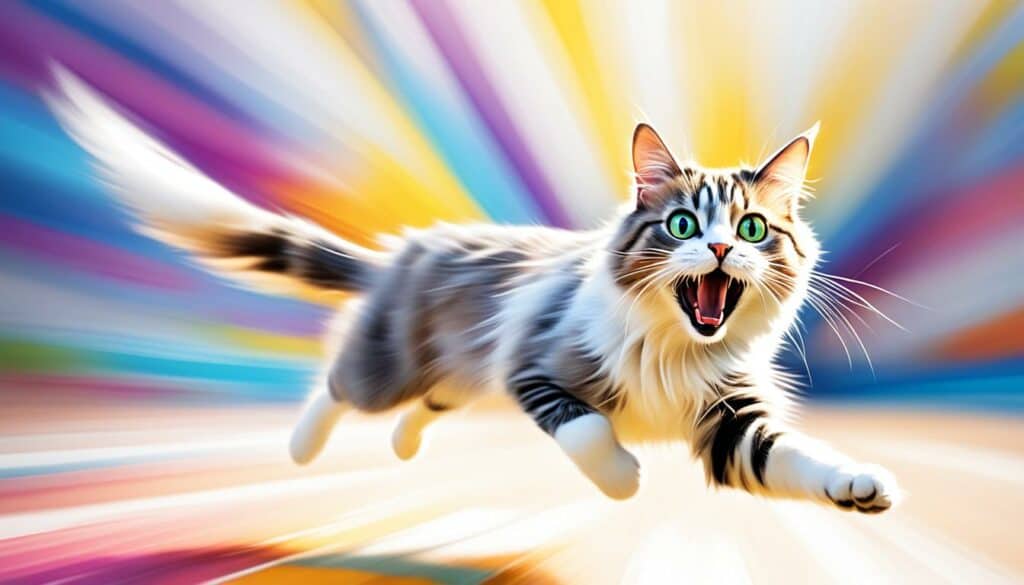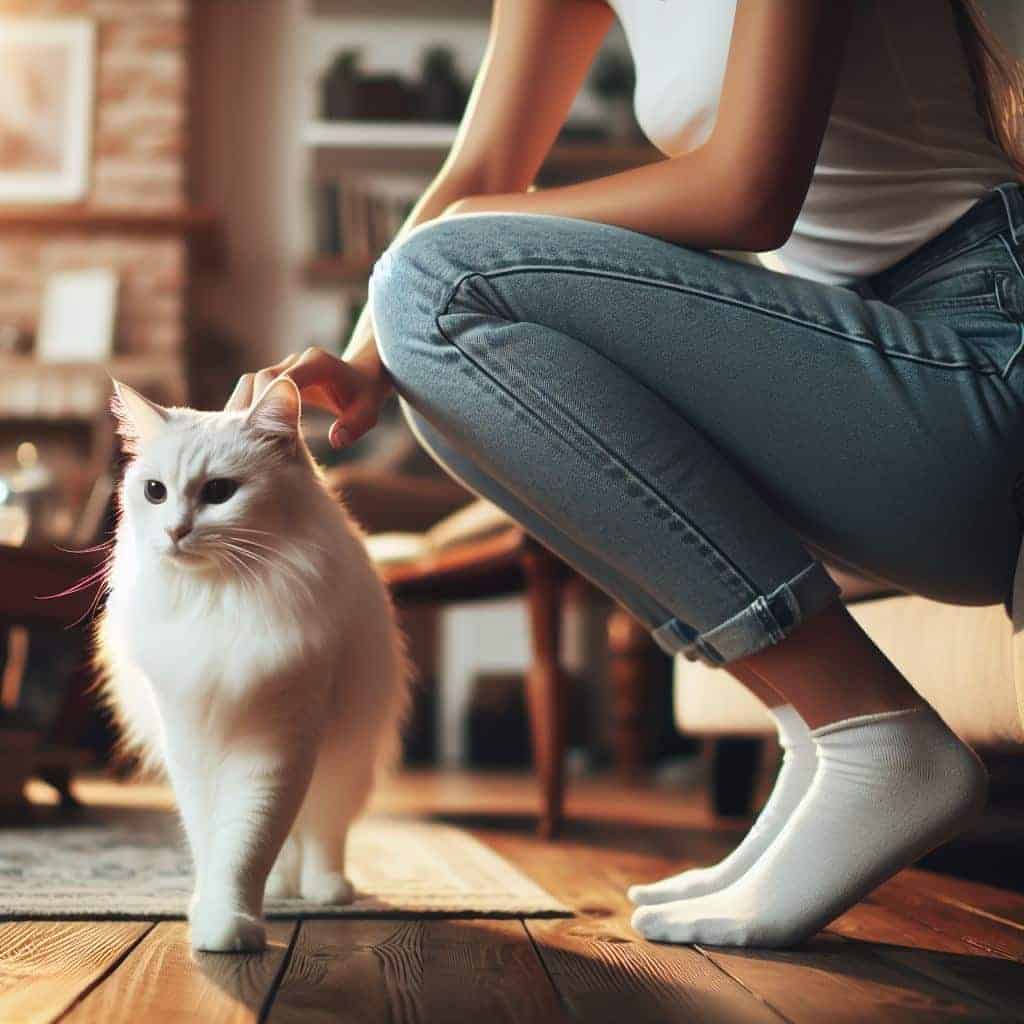Recent feline research has revealed that cats do dream and even exhibit similar brain patterns during their REM (rapid eye movement) sleep, which is associated with dreaming, just like humans do.
But what exactly do they dream about, and what triggers nightmares in our feline friends?
Understanding why this happens involves looking at their behavior, sleep patterns, and emotional states. In this article, you will learn about cat sleep patterns, explore their dreams, understand their sleep behavior, and uncover the causes of cat nightmares.
Understanding Cat Sleep Patterns
Cats are fascinating creatures, and their sleep patterns are quite different from those of humans. To understand why cats have nightmares, it’s essential to first look at how they sleep.
Sleep Stages in Cats
Cats experience several distinct stages of sleep, each serving different purposes for their overall health and well-being. Understanding these stages helps us appreciate how our feline friends rest and rejuvenate.
Light Sleep
Cats spend a significant amount of time in the light sleep stage, which bears similarities to the light sleep that humans experience. During this phase, their bodies remain somewhat active while enjoying rest.
Characteristics:
- Breathing is regular: In this stage, cats breathe steadily and rhythmically, indicating they are relaxed but still aware of their surroundings.
- They may twitch or move their paws as if they are dreaming: This twitching can be quite amusing to observe; it often reflects the cat’s engagement with dreams or memories from their waking hours.
- This stage allows cats to remain alert to their surroundings: Unlike deeper sleep stages where they are less responsive, light sleep enables cats to quickly wake up if necessary, keeping them vigilant against potential threats or disturbances.
Deep Sleep (Slow Wave Sleep)
The deep sleep stage is crucial for a cat’s overall health as it serves as a restorative phase where the body engages in essential repair processes. This is when many vital functions occur, helping maintain physical and mental well-being.
Characteristics:
- Breathing becomes slower and deeper: During deep sleep, a cat’s breathing slows down significantly compared to light sleep, reflecting a deep level of relaxation.
- The cat is less responsive to external stimuli: In this phase, cats become much harder to awaken; they might not respond even if there are noises or movements happening around them.
- This stage is crucial for overall health and recovery: Deep sleep plays an important role in allowing the cat’s body to recover from daily activities and stressors. It supports muscle repair and growth while also bolstering immune function.
REM Sleep (Rapid Eye Movement)
REM sleep is particularly fascinating because it is during this stage that dreaming occurs. This phase can include both pleasant dreams as well as nightmares, making it an intriguing aspect of feline behavior.
Characteristics:
- The cat’s eyes may move under their eyelids: You might notice your cat’s eyes darting beneath closed lids during REM sleep. This movement indicates that they are actively dreaming at that moment.
- They may vocalize, twitch, or exhibit other movements: It’s not uncommon for cats to make soft sounds or exhibit small twitches during this dream state; these behaviors provide insight into what might be occurring in their minds.
- This phase is important for processing experiences and emotions: Just like humans do during REM sleep, cats utilize this time to process memories and emotions from their waking life. This helps them work through daily experiences and potentially alleviate any stress or anxiety they might have encountered.
Understanding these various stages of sleep provides valuable insight into why cats need to have uninterrupted rest. By ensuring your feline friend has a comfortable sleeping environment, you can support their natural rhythms and contribute positively to their overall health.
How Much Do Cats Sleep?
Cats are renowned for their love of sleep, often indulging in 12 to 16 hours of rest daily. This extended slumber is not laziness but a biological imperative linked to their predatory instincts. As crepuscular hunters, cats conserve energy for bursts of activity by sleeping through much of the day. Their sleep cycles are unique, involving frequent short periods of deep and light sleep, allowing for alertness even while resting.
A cat’s sleep duration is influenced by various factors. Kittens and elderly cats typically sleep more due to growth and aging, respectively.
A comfortable and secure environment promotes longer sleep, while stress can disrupt sleep patterns. Understanding these factors is crucial for providing optimal care, as sufficient rest is essential for a cat’s overall health and well-being.
Creating a calm and enriching environment for your cat is key to supporting healthy sleep habits. By providing comfortable sleeping spots, minimizing disturbances, and engaging in interactive play, you can help your feline friend achieve the restorative rest they need to thrive.
Do Cats Have Nightmares?
Just like humans, cats are capable of having nightmares. Strong emotions such as stress, anxiety, and fear can trigger bad dreams in our feline friends. Cats, being sensitive creatures, are easily affected by changes in their routine or environment, which can contribute to sleep disturbances and nightmares.
When a cat is experiencing a nightmare, there are often telltale signs that can help us identify their distress. Cats may exhibit twitching, discomfort, and restless sleep during a bad dream. They may also vocalize or exhibit sudden movements while asleep. It’s important to note that it is best not to wake a cat during a nightmare, as it can startle them and potentially lead to aggression.
Instead, provide a calm and comforting environment to help them settle back into a peaceful sleep.
Understanding the factors that cause cat nightmares is important for the well-being of our furry companions. Stressful events, such as a visit to the veterinarian or a change in the household, can induce anxiety in cats and disrupt their sleep patterns.
Cats are creatures of habit and thrive in stable and familiar environments. Any abrupt changes in their surroundings can cause them to experience anxiety, ultimately leading to disturbed sleep and nightmares. Providing a consistent and calm environment can help alleviate their anxiety and minimize the occurrence of nightmares.
Nightmare Symptoms in Cats:
- Twitching
- Restlessness
- Discomfort
- Vocalization
- Sudden movements
Cat nightmares are not uncommon, but as responsible pet owners, we can take steps to reduce their frequency. Creating a safe and stress-free environment, maintaining a consistent routine, and providing mental stimulation and enrichment during their waking hours can contribute to a healthier sleep pattern and minimize anxiety-related nightmares.
Common Causes of Nightmares in Cats
Understanding why cats might experience nightmares can help you ensure their well-being. Here are some common causes:
Cats, like humans, can experience nightmares, and various environmental factors may contribute to this phenomenon. Understanding these factors can help create a more comfortable sleeping environment for your feline friend.
1. Stressful Situations
- Loud Noises: Sudden sounds like thunder, fireworks, or construction can startle cats and lead to anxiety during sleep.
- Changes in Routine: Cats thrive on routine. Changes such as moving to a new home or a new pet in the household can create stress.
2. Unfamiliar Environments
- New Surroundings: Cats may feel threatened or anxious in unfamiliar places, which can lead to nightmares.
- Lack of Safe Spaces: If a cat doesn’t have a designated safe area to retreat to, it may feel vulnerable and anxious.
3. Health Issues
- Physical Discomfort: Illness or pain can lead to restless sleep, increasing the likelihood of nightmares.
- Medications: Some medications can affect a cat’s sleep patterns and lead to vivid dreams or nightmares.
4. Social Interactions
- Aggressive Encounters: Negative interactions with other animals or even humans can cause fear and anxiety, which may manifest in nightmares.
- Lack of Socialization: Cats that are not adequately socialized may be more prone to stress and anxiety, affecting their sleep quality.
5. Environmental Enrichment
- Boredom: A lack of stimulation can lead to anxiety. Providing toys and activities can help reduce stress and promote better sleep.
- Overstimulation: Conversely, too much activity or chaos in the environment can also lead to stress and nightmares.
By being aware of these factors, you can take steps to create a more peaceful environment for your cat, potentially reducing the occurrence of nightmares. Remember to observe your cat’s behavior and make adjustments as needed to help them feel safe and secure.
Mitigating Nightmares
Nightmares can be a distressing experience not only for the cat but also for their owners. Understanding how to mitigate these nightmares is essential for ensuring your feline friend has a restful sleep.
Let’s explore various strategies that can help create a more peaceful sleeping environment and reduce the likelihood of nightmares.
Creating a Safe Environment
A secure and comfortable space is vital for any pet, especially cats who are naturally sensitive creatures. Here are some practical steps you can take:
- Cozy Bed: Provide a soft, warm bed in a quiet area away from household hustle and bustle. Consider using materials that retain heat, like fleece or memory foam.
- Safe Space: Create an enclosed area where your cat feels safe—this could be as simple as placing their bed inside a box or covered with blankets to mimic a den-like environment.
- Familiar Scents: Cats are comforted by familiar smells. Use items like old shirts or blankets that carry your scent to provide reassurance while they sleep.
Regular Vet Check-ups
Health issues can contribute significantly to nightmares in cats. Regular veterinary visits ensure that any underlying health problems are identified early on:
- Routine Health Checks: Schedule annual check-ups to monitor overall health, including dental care which plays an important role in general well-being.
- Vaccinations and Parasite Control: Ensure your cat is up-to-date on vaccinations and free from parasites (like fleas or ticks) which may cause discomfort during sleep.
Stress Reduction Techniques
Reducing stress is crucial in helping cats feel secure enough to have uninterrupted dreams:
- Playtime: Engage your cat in regular play sessions using toys like feather wands or laser pointers to expend energy before bedtime.
- Calming Products: Consider using calming pheromone diffusers (like Feliway) or sprays designed specifically for anxiety relief among pets.
- Gentle Routine: Establishing consistent daily routines helps cats feel more secure; feed them at the same time every day and maintain similar activity schedules.
By implementing these strategies collectively, you’re likely to see improvements not just in reducing nightmares but also in enhancing the overall well-being of your furry companion!
Summary
Factors such as stress and changes in their environment can contribute to nightmares in cats. Understanding cat sleep patterns can help us provide a stimulating and enriching environment for our furry friends, enhancing their dream experiences. By observing their behaviors during sleep, we can gain valuable insights into their dreamscapes and the content of their dreams.
Although we may never fully understand the precise content and meaning of cat dreams, we can appreciate the importance of sleep for our feline companions.
Creating a comfortable and stress-free sleeping environment for our cats can have a positive impact on their overall well-being.
So next time you see your cat twitching in their sleep, you can rest assured knowing that they are going through their unique dream experience.
Useful Reads
- https://cats.com/do-cats-dream
- https://www.trustedhousesitters.com/blog/pets/do-cats-dream/
- https://medium.com/stories-on-the-go/cats-and-dreams-exploring-the-mysterious-world-of-cat-sleep-06c6d6e9d6ff

In her previous life, Lisa traveled extensively, both for work and leisure. After the pandemic struck, Lisa locked up her luggage and adopted a cat ever since.
Lisa is now an avid cat lover, she devotes most of her free time serving as butler to her adorable feline at home. When she is not with her cat, she can be seen using her phone sourcing for the latest cat supplies online.


